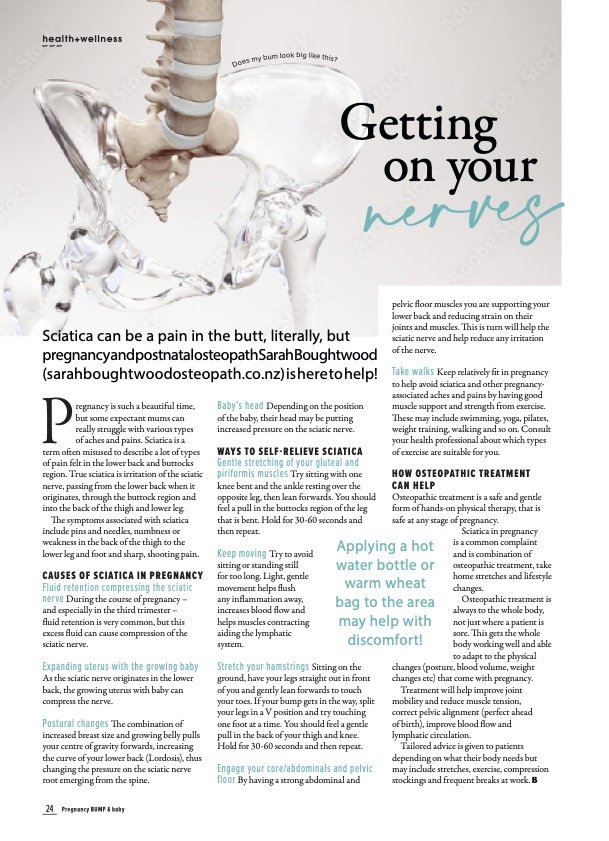Getting on your nerves
Pregnancy is such a beautiful time but some expectant mums can really struggle with various types of aches and pains. Sciatica is a term often misused to describe a lot of types of pain felt in the lower back and buttocks region. True Sciatica is irritation of the Sciatica nerve passing from the lower back where it originates, through the buttocks region and into the back of the thigh and lower leg.
The symptoms associated with Sciatica include;
● Pins and needles, numbness or weakness in the back of the thigh to the lower leg and foot
● Sharp, shooting pain
Causes in pregnancy:
● Fluid retention compressing the Sciatic nerve - During the course of pregnancy and especially in the third trimester, fluid retention is very common, but this excess fluid can cause compression of the Sciatic nerve.
● Expanding Uterus with the growing baby - As the Sciatica nerve originates in the lower back, the groing uterus with baby can compress the nerve.
● Postural changes- The combination of increased breast tissue size and growing belly, pulls your centre of gravity forwards, increasing the curve of your lower back (Lordosis) thus changing the pressure on the Sciatic nerve root emerging from thespine
● Baby’s head- Depending on the position of the baby, their head may be putting increased pressure on the Sciatic nerve
Ways to self relieve Sciatica
● Apply heat to the area
● Gentle stretching of your Gluteal & Piriformis muscles- Try sitting with one knee bent and the ankle resting over the opposite leg, then lean forwards. You should feel a pull in the buttocks region of the leg that is bent. Hold for 30-60 seconds and then repeat.
● Frequent breaks- Try avoid sitting or standing still for too long. Light, gentle movement helps flush any inflammation away, increases blood flow and helps muscles contracting aiding the lymphatic system.
● Stretch your hamstrings - Sitting on the ground, have your legs straight out in front of you and gently lean forwards to touch your toes. If your bump gets in the way, split your legs in a V position and try touching one foot at a time. You should feel a gentle pull in the back of your thigh and knee. Hold for 30-60 seconds and then repeat.
● Engage your core/abdominals and pelvic floor- By having a strong abdominal and pelvic floor muscles you are supporting your lower back and reducing strain on their joints and muscles. This is turn will help the Sciatic nerve and help reduce any irritation of the nerve.
● Walks- Keep relatively fit in pregnancy to help avoid Sciatica and other pregnancy ache and pains by having good muscle support and strength from exercise. Please consult your health professional about which types of exercise are suitable for you. These may include; swimming, yoga, pilates, weight training, walking and so on.
How Osteopathic treatment can help:
Osteopathic treatment is a safe and gentle form of hands-on physical therapy, that is safe at any stage of pregnancy. Sciatica in pregnancy is a common complaint and is combination of osteopathic treatment, take home stretches and lifestyle changes. Osteopathic treatment is always to the whole body, not just where a patient is sore. This gets the whole body working well and able to adapt to the physical changes (posture, blood volume, weight changes etc) that come with pregnancy. Treatment will help improve joint moblity and reduce muscle tension, correct pelvic alignment (perfect ahead of birth), improve blood flow and lymphatic circulation. Tailored advice is given to patients depending on what their body needs. This might include; stretches, exercise, compression stockings, frequent breaks at work and soon.
Pregnancy Osteopath
Sarah Boughtwood
www.sarahboughtwoodosteopath.co.nz

